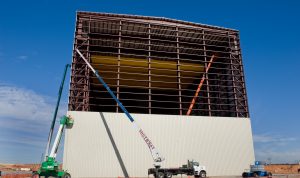Pre-Engineered Metal Buildings Compared to Wood-Framed Buildings
Posted on May 24, 2017 by Ceco Building SystemsThe Metal Building Manufacturers Association (MBMA) tells us that over the past 80 years more than 14 million metal building systems have been constructed in a wide range of building types and sizes. They have grown in popularity to the point that MBMA estimates that 48% of the low-rise buildings built in the United States utilize metal building systems. Why do pre-engineered metal buildings enjoy such popularity? It becomes readily apparent when compared to the alternative forms of construction available. 
In this post, we will identify some of the advantages that metal buildings have over conventional wood-framed construction, which is sometimes seen as a common, inexpensive way to construct not only residential buildings, but light commercial buildings as well. In a future post, we will make a similar comparison between metal buildings and construction using concrete and masonry.
Metal Building Advantages over Wood Buildings:
Design Flexibility: Wood structural members have some notable limitations on their capabilities, such as clear spans of floors and roofs. That means that structural wood walls or columns and beams need to be located close together, which may or may not be conducive to a particular building design scheme. The steel in metal buildings allows for longer spans and greater design flexibility. The stronger material also means that the depth of the steel members does not need to be as deep as wood members, saving on the space required and helping to economize the overall construction.
Energy Efficiency: The insulating properties of insulated metal panels (IMPs) offer significant R-values, which can readily meet or exceed current energy codes and contribute toward credits in the Leadership in Energy and Environmental Design (LEED) Green Building Rating System. Because of the higher R-value insulation used in IMPs, less space is needed for the insulation compared to typical wood wall assemblies.
Fire-Resistant Construction: Metal building construction provides a non-flammable and non-combustible material for construction. As such it can qualify for different construction types under the building code than wood does. That can help in other ways, such as allowable floor areas and sprinkler requirements.
Low Maintenance: Steel building materials are inherently stronger and more durable than wood, meaning they typically require less maintenance, helping owners save money over the life of the building.
Pre-finished Materials: Most of the visible components of a metal building can be provided pre-finished in the factory. That includes exposed structural members, panels, and even fasteners such as screws and nails. Pre-finishing assures consistent and uniform appearance but also saves construction time compared to field-finishing wood products and systems.
Weather Tolerance: Wood construction can be very dependent on favorable weather conditions. Sudden rainstorms or melting snow can penetrate wood products and cause swelling or other damage that can compromise the structural performance or appearance of wood. Steel construction is not prone to the same type of damage from the weather as wood is. That means the integrity of the metal building systems can remain intact without the need to worry about removing and redoing wood construction work.
With the number of ways that pre-engineered metal buildings provide advantages over wood construction, it is easy to see why they remain such a popular choice for low-rise buildings of many different types. Learn more at http://www.mbma.com or https://www.cecobuildings.com.

